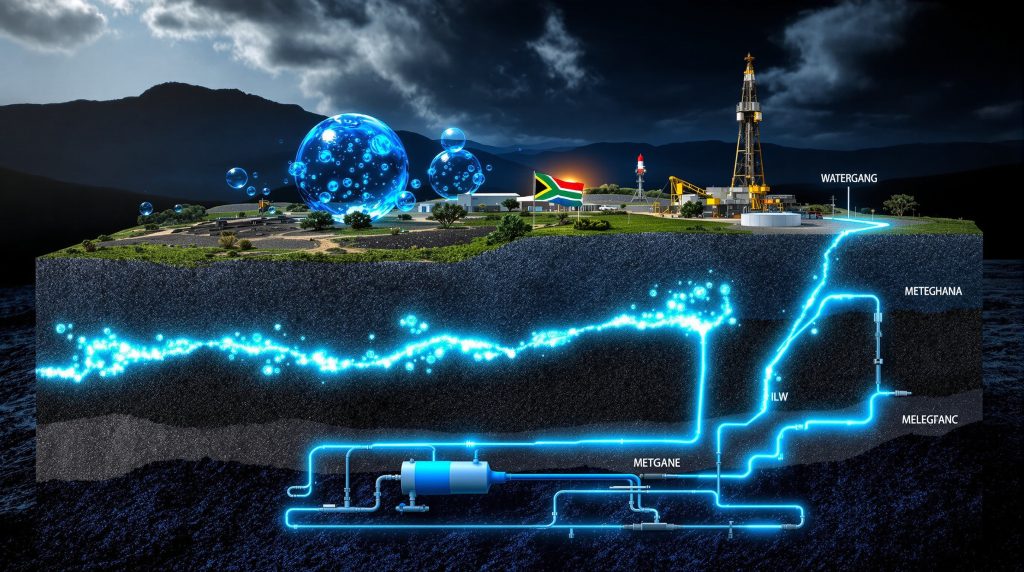What is Coal Bed Methane and Why is South Africa Exploring This Resource?
Coal bed methane (CBM) represents an untapped energy resource within South Africa's extensive coal deposits. This naturally occurring form of natural gas is found within coal seams and requires specialized extraction techniques to bring to the surface.
With South Africa's abundant coal reserves—estimated at 53.2 billion tonnes as of 2020—CBM offers significant potential as a cleaner transitional energy source. The Waterberg coalfield in Limpopo province, which contains approximately 75% of South Africa's remaining coal reserves, is particularly promising for CBM development.
CBM formation occurs through natural geological processes over millions of years as organic matter in coal seams generates methane gas. Unlike conventional natural gas, which is typically found in porous rock formations, CBM is adsorbed directly onto the coal matrix, requiring different extraction approaches.
The Science Behind Coal Bed Methane Formation
CBM is formed through a process called coalification, where plant matter is gradually transformed into coal under heat and pressure over millions of years. During this process, methane gas is generated and becomes trapped within the microscopic pores of the coal seam.
The gas remains bound to the coal until pressure is reduced, typically through dewatering the coal seam. This process allows the methane to detach from the coal and flow through natural fractures toward extraction wells.
What makes CBM particularly valuable is its composition—typically 95-98% methane with minimal processing required compared to conventional natural gas, which often contains various other hydrocarbons and impurities.
South Africa's Energy Landscape and the Role of CBM
South Africa's energy sector currently relies heavily on coal, with approximately 80% of electricity derived from coal-fired power plants. This dependence presents significant challenges in meeting climate commitments while ensuring energy transition strategies.
Coal bed methane South Africa produces 50-60% lower CO2 emissions compared to coal-fired power generation, making it an attractive transitional fuel in South Africa's evolving energy landscape. As the country works toward its goal of reducing greenhouse gas emissions by 42% below 2025 levels by 2030, CBM can serve as an important bridge technology.
Beyond emissions reduction, CBM offers several strategic advantages for South Africa:
- Utilization of existing coal resources in a more environmentally responsible manner
- Reduced reliance on imported energy sources
- Complementary role with renewable energy by providing stable baseload power
- Potential for economic diversification in coal-dependent regions
Energy experts note that CBM can serve as a critical "bridge fuel" during South Africa's transition from coal dependency to renewable energy sources, providing stability while the renewable sector develops.
How is the Waterberg Coalfield Becoming South Africa's CBM Frontier?
The Waterberg coalfield in Limpopo province has emerged as the focal point for South Africa's first commercial CBM development. This region offers ideal geological conditions for CBM extraction, with coal seams containing significant methane concentrations.
Geological Advantages of the Lephalale Region
The Waterberg Basin features several favorable characteristics for CBM development:
- Extensive coal deposits with suitable depth and pressure conditions
- Coal seams with sufficient gas content and permeability
- Relatively consistent geological structures
- Accessible locations for well placement and infrastructure development
These conditions have attracted substantial investment in CBM exploration and development, most notably Thungela Resources' pioneering project.
Thungela's R400 Million Pioneer Project
Thungela Resources is leading South Africa's first significant CBM initiative with its Lephalale project in the Waterberg coalfield. This landmark development represents a R400 million investment in domestic gas production and includes:
- A modular liquefied natural gas (LNG) plant
- Associated infrastructure for gas processing
- Initial focus on power generation at Thungela's mining operations
- Capability to alleviate load curtailment during electricity shortages
The project has reached several important milestones:
| Development Stage | Status | Timeline |
|---|---|---|
| Initial exploration | Completed | Since 1992 |
| Pilot production testing | Completed | 10-year period |
| Environmental monitoring | Ongoing | 20+ years |
| Well stimulation | 5 wells successfully stimulated | Recent |
| Feasibility study | In progress | Current phase |
| Bulk sampling program | Approved | January 2025 |
This methodical approach over three decades demonstrates the technical viability of CBM extraction in South Africa's unique geological conditions while establishing environmental safety protocols for future developments.
What Technical Approaches Enable Successful CBM Extraction?
CBM extraction in South Africa requires specialized techniques adapted to the unique characteristics of local coal seams. The Lephalale project has pioneered approaches specifically tailored to South African geological conditions.
Specialized Drilling and Stimulation Techniques
The primary technical approaches used in the Waterberg CBM project include:
-
Low-pressure, low-volume hydraulic stimulation: Unlike high-pressure fracking used in shale gas development, CBM extraction in the Waterberg uses gentler stimulation methods to enhance natural fractures within coal seams.
-
Dewatering processes: Reducing water pressure within coal seams is essential for releasing trapped methane. This requires specialized pumping equipment and water management protocols.
-
Directional drilling: Modern drilling programs overview allows access to coal seams from optimal surface locations, minimizing environmental footprint.
-
Well completion designs: Specialized well casing and perforation designs ensure efficient gas collection while protecting groundwater resources.
These approaches differ significantly from conventional natural gas extraction techniques, reflecting the unique nature of coal bed methane resources.
From Extraction to Utilization: The CBM Value Chain
Once extracted, CBM requires processing before utilization. The Lephalale project's approach includes:
- Gas collection and compression from multiple well sites
- Water separation and treatment systems
- Modular liquefaction technology for converting methane to LNG
- Storage and transportation infrastructure for delivering gas to end users
- Power generation facilities at Thungela's mining operations
The modular design of these systems allows for scalable development, with initial focus on power generation before potentially expanding to other applications as production volumes increase.
How Does CBM Development Address Environmental Concerns?
Environmental management represents a critical aspect of CBM development in South Africa, particularly given the country's water scarcity challenges and climate commitments. The Lephalale project has implemented comprehensive environmental monitoring and protection measures.
Water Management in a Water-Scarce Region
Water management is perhaps the most significant environmental consideration for CBM development in South Africa. The Lephalale project addresses these concerns through:
-
Baseline studies: Comprehensive water quality and quantity assessments conducted before development to establish reference conditions.
-
Continuous monitoring: Over 20 years of water monitoring data collection, providing one of the most extensive environmental datasets for CBM operations in Africa.
-
Produced water handling: Specialized systems for managing water pumped from coal seams, including treatment and potential beneficial reuse.
-
Aquifer protection measures: Well casing designs and monitoring protocols to prevent cross-contamination between aquifers.
The project's long-term environmental monitoring has demonstrated that properly designed and managed CBM operations can coexist with water resource protection, with no reported incidents of water contamination over the monitoring period.
Emissions Profile and Climate Considerations
Beyond water management, CBM development must address greenhouse gas emissions considerations:
-
Methane leak prevention: Specialized equipment and monitoring to prevent fugitive methane emissions, which have significant global warming potential.
-
Combustion emissions advantage: When used for power generation, CBM produces approximately 50-60% less CO2 per unit of electricity compared to coal.
-
Life-cycle assessment: Comprehensive evaluation of emissions across the entire value chain to ensure climate benefits are realized.
The climate benefits of CBM are maximized when methane that would otherwise escape to the atmosphere through coal mining is instead captured and used productively, replacing higher-carbon fuels.
What Economic Benefits Can CBM Bring to South Africa?
Beyond energy production, CBM development offers substantial economic development potential for South Africa, particularly in regions historically dependent on coal mining.
Job Creation and Skills Development Opportunities
The CBM sector creates employment opportunities across several categories:
- Direct jobs in drilling, well maintenance, gas processing, and power generation
- Indirect employment through supply chains and supporting services
- Specialized technical roles requiring training in emerging energy technologies
- Construction and infrastructure development positions during project development
These opportunities are particularly valuable in the context of South Africa's coal sector transition, potentially providing alternative careers for workers in traditional coal mining.
Regional Economic Transformation Potential
The broader economic impacts of CBM development extend beyond direct employment to include:
- Infrastructure investment in gas processing, transportation, and utilization
- Local business participation throughout the CBM value chain
- Municipal revenue enhancement through expanded economic activity
- Diversification of coal-dependent regional economies
- Technology transfer and skills development in emerging energy sectors
Thungela's CEO July Ndlovu noted that the Lephalale project "has the potential to unlock further infrastructure investment, local business participation, skills transfer and development. Over time, it will stimulate the development of new industries and markets, drive demand for local goods and services, and strengthen municipal revenues fostering a sustained cycle of regional growth and economic resilience."
How Does South Africa's Regulatory Framework Support CBM Development?
CBM development in South Africa operates within a complex regulatory framework that continues to evolve as the sector develops.
Evolution of Gas Regulation in South Africa
The regulatory landscape for CBM in South Africa includes:
- Mineral and Petroleum Resources Development Act governing exploration and production rights
- National Environmental Management Act establishing environmental impact assessment requirements
- National Water Act providing water use authorization frameworks
- Gas Act addressing downstream gas utilization and infrastructure
CBM presents unique regulatory challenges as it spans both mining and petroleum regulatory frameworks. Successful development requires navigation of these overlapping jurisdictions.
Government Perspective on Gas as Transition Fuel
South Africa's government has increasingly recognized gas as a vital transitional energy source. Minister of Mineral Resources and Energy, Gwede Mantashe, during his visit to the Lephalale project site, emphasized "the importance of gas as a transitional energy technology vital for economic growth, advocating for a balanced approach combining gas development and environmental protection."
This perspective aligns with South Africa's Integrated Resource Plan, which identifies natural gas as playing an increasing role in the country's energy mix during the transition toward renewable energy dominance.
What Challenges Must South Africa's CBM Sector Overcome?
Despite its potential benefits, CBM development in South Africa faces several significant challenges that must be addressed for the sector to achieve commercial viability.
Technical and Geological Hurdles
South Africa's coal seams present unique technical challenges:
- Variable gas content and quality across different coal formations
- Complex geological structures affecting well placement and productivity
- Water management requirements in a water-scarce environment
- Production decline characteristics requiring ongoing well development
Addressing these challenges requires adaptation of international best practices to South African conditions, with continued innovation in drilling, stimulation, and production techniques.
Market Development and Commercial Viability
Beyond technical challenges, CBM development faces market and economic hurdles:
- Gas infrastructure limitations restricting market access
- Pricing mechanisms that enable competitive positioning against alternative fuels
- Investment attraction in a capital-constrained environment
- Scale requirements to achieve economic viability
- Regulatory certainty needed for long-term investment decisions
The Lephalale project's approach of starting with captive power generation before expanding to broader markets represents a pragmatic response to these challenges, allowing gradual development of both technical capacity and market structures.
How Does South Africa's CBM Potential Compare Globally?
South Africa's CBM development exists within a global context where several countries have established commercial production, providing both competition and learning opportunities.
International CBM Development Benchmarks
Several countries have developed significant CBM industries, offering valuable comparisons:
| Country | CBM Development Status | Key Characteristics |
|---|---|---|
| United States | Mature industry | Extensive production history, developed regulations |
| Australia | Advanced commercial development | Major LNG exports from CBM |
| China | Rapidly expanding | Strategic focus on domestic gas supply |
| India | Emerging development | Similar developing economy context |
| South Africa | Early commercial stage | First major project under development |
These international experiences provide important lessons for South Africa, though geological conditions and market contexts differ significantly between regions.
South Africa's Competitive Position
South Africa possesses several advantages for CBM development:
- Extensive coal resources with associated methane potential
- Established mining expertise and infrastructure that can be leveraged
- Domestic market for gas particularly for power generation
- Integration potential with existing energy infrastructure
- Strong technical capabilities in related sectors
However, South Africa also faces challenges in competing for investment capital with more established CBM regions, requiring policy frameworks that recognize the developmental stage of the sector.
What Future Developments Can We Expect in South Africa's CBM Sector?
The future of CBM in South Africa depends on several factors, including technical success of pioneer projects, regulatory evolution, and market development.
Expansion Beyond the Demonstration Phase
If Thungela's Lephalale project demonstrates commercial viability, several developments could follow:
- Additional exploration in other parts of the Waterberg and other coal basins
- Increased investment from both domestic and international companies
- Expansion of production capacity as technical approaches are refined
- Development of specialized service industries supporting CBM operations
- Integration with broader gas infrastructure planning
The bulk sampling program approved for January 2025 represents a critical step toward establishing this commercial viability.
Long-term Contribution to Energy Transition
Looking further ahead, CBM could play several roles in South Africa's energy transition:
- Replacing coal in power generation during the phase-down of coal-fired plants
- Supporting renewable energy integration by providing dispatchable power
- Potential feedstock for hydrogen production as part of future clean energy systems
- Enabling industrial fuel switching from coal to lower-carbon alternatives
The scale of this contribution depends on both resource potential—which remains incompletely assessed—and policy frameworks supporting gas as a transition fuel. According to the African Mining Magazine, coal bed methane South Africa could play a crucial role in addressing both energy security and mineral beneficiation in South Africa.
Frequently Asked Questions About Coal Bed Methane in South Africa
How does CBM extraction differ from fracking?
CBM extraction in South Africa employs low-pressure, low-volume hydraulic stimulation techniques that differ significantly from the high-pressure hydraulic fracturing ("fracking") associated with shale gas development.
The Lephalale project uses controlled stimulation methods specifically designed for coal seams, with lower water and pressure requirements than typical shale gas operations. This approach has been developed over decades of testing to address the specific characteristics of South African coal formations.
What safeguards protect water resources during CBM operations?
The Lephalale project has implemented comprehensive water protection measures, including:
- Baseline water quality monitoring established over 20+ years
- Multi-layer well casing designs to isolate aquifers
- Continuous monitoring throughout operations
- Specialized water management protocols for produced water
These measures have demonstrated effectiveness, with no reported water contamination incidents over the project's extensive monitoring period.
How will CBM development affect local communities?
CBM development creates both opportunities and responsibilities for local communities:
- Employment opportunities across various skill levels
- Business development potential in the CBM value chain
- Municipal revenue enhancement through expanded economic activity
- Skills development programs for local workforce
- Environmental monitoring and community engagement requirements
Successful CBM projects require meaningful engagement with local communities, including transparent communication about potential impacts, benefits sharing, and participation in environmental monitoring programs.
What role will CBM play in South Africa's just energy transition?
As South Africa navigates its energy transition, CBM can contribute in several ways:
- Providing lower-carbon alternatives to coal for power generation
- Creating new economic opportunities in coal-dependent regions
- Utilizing existing mining skills for alternative energy development
- Supporting grid stability as renewable penetration increases
- Enabling phased transition that maintains energy security
The "just" aspect of the transition requires careful attention to ensuring benefits are shared equitably and that communities currently dependent on coal are supported through the change. Furthermore, mining industry transformation will need to include mine reclamation innovations to ensure sustainable development of these resources.
Ready to Identify the Next Major Mineral Discovery?
Gain real-time alerts on significant ASX mineral discoveries with Discovery Alert's proprietary Discovery IQ model, transforming complex mineral data into actionable investment insights. Visit our dedicated discoveries page to understand how major mineral discoveries have historically generated substantial returns, and position yourself ahead of the market with our 30-day free trial.




